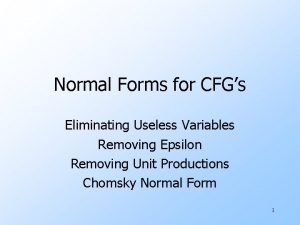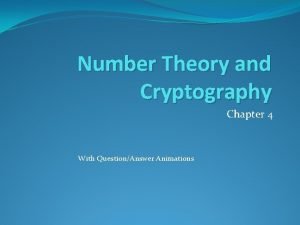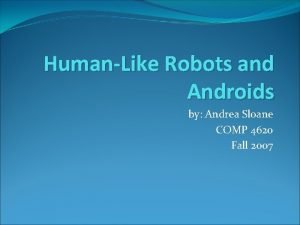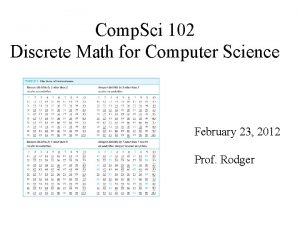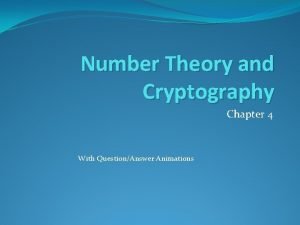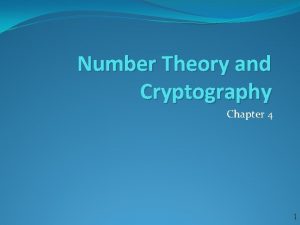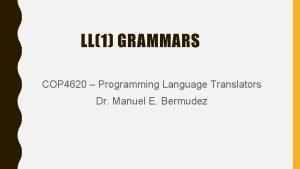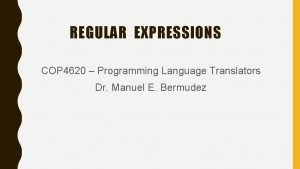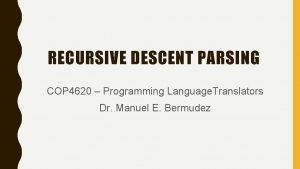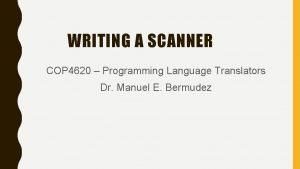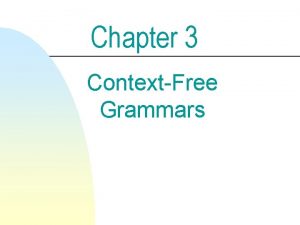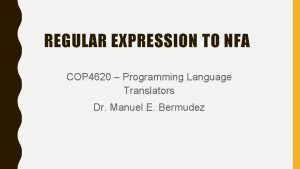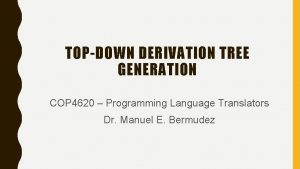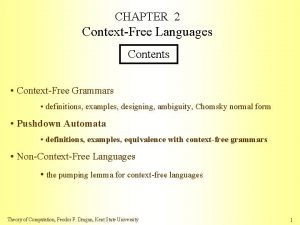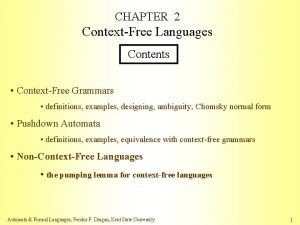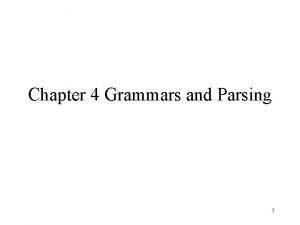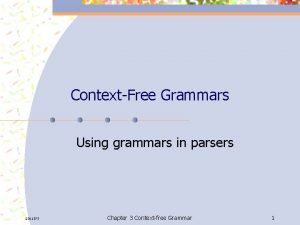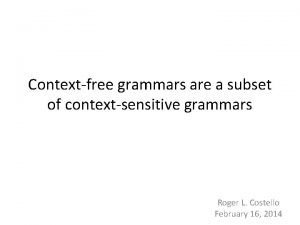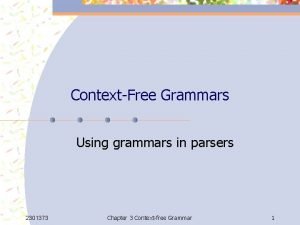CONTEXTFREE GRAMMARS COP 4620 Programming Language Translators Dr




















- Slides: 20

CONTEXT-FREE GRAMMARS COP 4620 – Programming Language Translators Dr. Manuel E. Bermudez

TOPICS Context-free Grammars Derivation Trees Transduction Grammars Ambiguity Grammar Reduction.

CONTEXT-FREE GRAMMARS • Definition: A context-free grammar (CFG) is a quadruple G = ( , , P, S), where all productions are of the form A → , for A ∊ and ∊ ( ∪ )*. • Re-writing using grammar rules: – βAγ ⇒ β γ if A → (derivation). • Left-most derivation: At each step, the left-most nonterminal is re-written. • Right-most derivation: At each step, the right-most nonterminal is re-written.

SAMPLE GRAMMAR AND DERIVATIONS

DERIVATION TREES • Describe re-writes, independently of the order (left -most or right-most). • Each tree branch matches a production rule in the grammar. • Leaves are terminals. • Bottom contour is the sentence. • Left recursion causes left branching. • Right recursion causes right branching.

TRANSDUCTION GRAMMARS Definition: A transduction grammar (a. k. a. syntax-directed translation scheme) is like a CFG, except for the following generalization: Each production is a triple (A, β, ω) Ф x V*, called a translation rule, denoted A → β => ω, where A is the left part, β is the right part, and ω is the translation part.

TRANSDUCTION GRAMMARS Translation of infix to postfix expressions. E→E+T →T T→P*T => E T + => T => P T * →P => P P → (E) => E →i => i The translation part describes how the output is generated, as the input is derived. Derivation: ( E, E) => ( E + T, E T + ) => ( T + T, TT+) => ( P + T, PT+) => ( i + T, i. T+) => ( i + P * T, i P T * + ) => ( i + i * T, i i T * + ) => ( i + i * i, i i i * + )

TRANSDUCTION GRAMMARS Transduction to Abstract Syntax Trees N Notation: < N t 1 … tn > denotes t … t 1 n String-to-tree transduction grammar: E→E+T →T T→P*T => < + E T > => T Derivation: (E, E) => (E+T, => (T+T, => (P+T, => (i+P*T, => (i+i*P, => (i+i*i, => < * P T > →P => P P → (E) => E →i => i <+E T>) <+T T>) <+P T>) <+i<*P T>>) <+i<*i P>>) <+i<*i i>>) + i * i i

TRANSDUCTION GRAMMARS Definition: A transduction grammar is simple if for every rule A → => β, the sequence of nonterminals in is identical to the sequence in β. E → E + T => < + E T > →T T→P*T => < * P T > →P => P P → (E) => E →i => i Notation: dispense with nonterminals and tree notation: in the translation parts, leaving: E → E + T => + →T T → P * T => * →P P → (E) →i => i Look familiar ? AST !!

GRAMMAR AMBIGUITY • Goal of parsing: – Examine input string, determine whether it's legal. – Same as: try to build derivation tree. – Therefore, tree should be unique. • Definition: A CFG is ambiguous if there exist two different right-most (or left-most, but not both) derivations for some sentence z. • (Equivalent) Definition: A CFG is ambiguous if there exist two different derivation trees for some sentence z.

CLASSIC AMBIGUITIES • Simultaneous left/right recursion: E→ E+E → i • Dangling else problem: S → if E then S else S → … Ambiguity is undecidable: no algorithm exists.

GRAMMAR REDUCTION What language does this grammar generate? S→a D → EDBC A → BCDEF E → CBA B → ASDFA F→S C → DDCF L(G) = {a} Problem: Many nonterminals (and productions) cannot be used in the generation of any sentence.

GRAMMAR REDUCTION Definition: A CFG is reduced iff for all A Ф, a) b) S =>* αAβ, for some α, β V*, (we say A is generable), A =>* z, for some z Σ* (we say A is terminable). G is reduced iff every nonterminal A is both generable and terminable. Example: S → BB B → b. B A → a. A →a B is not terminable, since B =>* z, for any z Σ*. A is not generable, since S =>* αAβ, for any α, β V*.

GRAMMAR REDUCTION To find out which nonterminals are generable: 1. Build the graph (Ф, δ), where (A, B) δ iff A → αBβ is a production. 2. Check that all nodes are reachable from S. Example: S → BB B → b. B A → a. A →a A is not reachable from S, so A is not generable. S B A

GRAMMAR REDUCTION Algorithmically, Generable : = {S} while(Generable changes) do for each A → Bβ do if A Generable then Generable : = Generable U {B} od { Now, Generable contains the nonterminals that are generable }

GRAMMAR REDUCTION To find out which nonterminals are terminable: 1. Build the graph (2 Ф, δ), where (N, N U {A}) δ iff A → X 1 … Xn is a production, and for all i, Xi Σ or Xi N. 2. Check that the node Ф (set of all nonterminals) is reachable from node ø (empty set). ø {B} {A, B} Example: S → BB A → a. A B → b. B →a {A} {A, S, B} not reachable from ø ! Only {A} is reachable from ø. Thus S and B are not terminable. {A, S} {A, S, B} {B, S}

GRAMMAR REDUCTION Algorithmically, Terminable : = { }; while (Terminable changes) do for each A → X 1…Xn do if every nonterminal among the X’s is in Terminable then Terminable : = Terminable U {A} od { Now, Terminable contains the nonterminals that are terminable. }

GRAMMAR REDUCTION Reducing a grammar: 1. Find all terminable nonterminals. 2. Remove any production A→X 1…Xn if any Xi is not terminable. 3. Find all generable nonterminals. 4. Remove any production A → X 1 … Xn if A is not generable.

GRAMMAR REDUCTION Example: E→E+T →T T→F*T →P F → not F Q→P/Q P → (E) →i Terminable: {P, T, E}, not Terminable: {F, Q}. So, eliminate every production whose right-part contains either F or Q. E→E+T →T T→P P → (E) →i Generable: {E, T, P}, not Generable: { }. Grammar is reduced.

SUMMARY Context-free Grammars Derivation Trees Transduction Grammars Ambiguity Grammar Reduction.
 Translators
Translators Translators and facilities of languages
Translators and facilities of languages Good cop bad cop interrogation
Good cop bad cop interrogation Cop 1 cop 2
Cop 1 cop 2 Unrestricted grammar
Unrestricted grammar Handling questions in context-free grammars
Handling questions in context-free grammars Every linear grammar generates a regular language
Every linear grammar generates a regular language Eliminating epsilon productions from cfg
Eliminating epsilon productions from cfg Unrestricted grammar example
Unrestricted grammar example Find an inverse of 101 modulo 4620
Find an inverse of 101 modulo 4620 Actroid
Actroid Inverse of 101 modulo 4620
Inverse of 101 modulo 4620 The number 311-38 is divisible by prime numbers:
The number 311-38 is divisible by prime numbers: Find an inverse of 101 modulo 4620
Find an inverse of 101 modulo 4620 What is hardware description language
What is hardware description language Perbedaan linear programming dan integer programming
Perbedaan linear programming dan integer programming Greedy algorithm vs dynamic programming
Greedy algorithm vs dynamic programming What is system programming
What is system programming Linear vs integer programming
Linear vs integer programming Perbedaan linear programming dan integer programming
Perbedaan linear programming dan integer programming Refrigerant cop
Refrigerant cop







